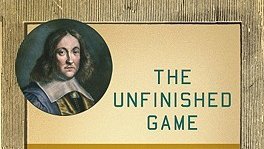
The book “The unfinished game” by @profkeithdevlin, is a fascinating account of the history of probability theory. Here are a 13 things that I learned: #mathreads #iteachmath
1. Probability theory is often considered to have started with an exchange of letters between Pascal
1. Probability theory is often considered to have started with an exchange of letters between Pascal

and Fermat in 1654. In the letters they try to solve a tricky gambling problem called “The problem of points”.
2. Before their exchange, many learned people (including leading mathematicians) believed that predicting the likelihood of a future event was simply not possible.
2. Before their exchange, many learned people (including leading mathematicians) believed that predicting the likelihood of a future event was simply not possible.
The future was a matter determined by God. In that sense, Fermat’s and Pascal’s ideas were a leap of thought.
3. The first known attempt to discern patterns in games of chance, dates to around 960, when Bishop Wibold of Cambrai, enumerated the 56 outcomes when 3 dice are thrown
3. The first known attempt to discern patterns in games of chance, dates to around 960, when Bishop Wibold of Cambrai, enumerated the 56 outcomes when 3 dice are thrown
simultaneously. In the 13th century, a latin poem listed the 216 outcomes when you take order into account.
4. During the 14th century, dice games were supplemented by card games, but no effort was made to tabulate and analyze frequencies of different hands until
4. During the 14th century, dice games were supplemented by card games, but no effort was made to tabulate and analyze frequencies of different hands until
the 15th century. (Note that this was still well before Fermat and Pascal.)
5. The Italian mathematician Cardano wrote "Book on Games of chance” where he formulated what we today refer to as the addition rule and product rule of probability.
5. The Italian mathematician Cardano wrote "Book on Games of chance” where he formulated what we today refer to as the addition rule and product rule of probability.
6. In 1494 Luca Pacioli first put into print the problem that Fermat and Pascal would later discuss and solve two centuries later. Several mathematicians tried their hands at the problem, including Luca Pacioli, Cardano, Tartaglia, Forestani, Galileo Galilei, but neither of them
solved it.
7. Fermat is often described as an amateur mathematician, but this is true only in the sense that he was not paid for his research. He devoted immense amounts of time on it.
7. Fermat is often described as an amateur mathematician, but this is true only in the sense that he was not paid for his research. He devoted immense amounts of time on it.
8. John Graunt – the man who first analyzed mortality tables – can be seen as the founder of statistics. No one before him had tried to analyze the masses of data that had been collected.
Among other things he estimated the number of inhabitants in London, showed that boys
Among other things he estimated the number of inhabitants in London, showed that boys
and girls were born in roughly equal measures and estimated the number of men in fighting age in London.
9. Before the word statistics was used, the word used in English was “political arithmetic”.
9. Before the word statistics was used, the word used in English was “political arithmetic”.
10. The mathematician Christiaan Huygens built on the ideas of Fermat and Pascal and wrote the first account of modern probability theory. He introduced the concept expectation.
11. The first application of probability theory outside of the gaming tables came in law. The
11. The first application of probability theory outside of the gaming tables came in law. The
question of interest was how much time must have passed, after an individual has gone absent, before the court decides that he’s dead.
12. Using method’s of calculus as well as probability theory, de Moivre showed how a collection of random observations would distribute
12. Using method’s of calculus as well as probability theory, de Moivre showed how a collection of random observations would distribute
themselves around their average value. He also introduced the standard deviation.
13. 80 years later, Gauss discovered that the errors in taking measurements gave rise to a normal distribution. He also realized one could use the bell curve to assign probabilities to events.
13. 80 years later, Gauss discovered that the errors in taking measurements gave rise to a normal distribution. He also realized one could use the bell curve to assign probabilities to events.
• • •
Missing some Tweet in this thread? You can try to
force a refresh






